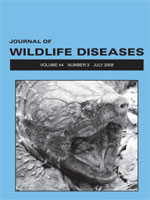Plague, caused by the bacterium Yersinia pestis, causes die-offs of colonies of prairie dogs (Cynomys ludovicianus). It has been argued that other small rodents are reservoirs for plague, spreading disease during epizootics and maintaining the pathogen in the absence of prairie dogs; yet there is little empirical support for distinct enzootic and epizootic cycles. Between 2004 and 2006, we collected blood from small rodents captured in colonies in northern Colorado before, during, and for up to 2 yr after prairie dog epizootics. We screened 1,603 blood samples for antibodies to Y. pestis, using passive hemagglutination and inhibition tests, and for a subset of samples we cultured blood for the bacterium itself. Of the four species of rodents that were common in colonies, the northern grasshopper mouse (Onychomys leucogaster) was the only species with consistent evidence of plague infection during epizootics, with 11.1–23.1% of mice seropositive for antibody to Y. pestis during these events. Seropositive grasshopper mice, thirteen-lined ground squirrels (Spermophilus tridecemlineatus), and deer mice (Peromyscus maniculatus) were captured the year following epizootics. The appearance of antibodies to Y. pestis in grasshopper mice coincided with periods of high prairie dog mortality; subsequently, antibody prevalence rates declined, with no seropositive individuals captured 2 yr after epizootics. We did not detect plague in any rodents off of colonies, or on colonies prior to epizootics, and found no evidence of persistent Y. pestis infection in blood cultures. Our results suggest that grasshopper mice could be involved in epizootic spread of Y. pestis, and possibly, serve as a short-term reservoir for plague, but provide no evidence that the grasshopper mouse or any small rodent acts as a long-term, enzootic host for Y. pestis in prairie dog colonies.
How to translate text using browser tools
1 July 2008
Exposure of Small Rodents to Plague during Epizootics in Black-tailed Prairie Dogs
Paul Stapp,
Daniel J. Salkeld,
Rebecca J. Eisen,
Ryan Pappert,
John Young,
Leon G. Carter,
Kenneth L. Gage,
Daniel W. Tripp,
Michael F. Antolin

Journal of Wildlife Diseases
Vol. 44 • No. 3
July 2008
Vol. 44 • No. 3
July 2008
Cynomys ludovicianus
epizootics
Onychomys leucogaster
plague
Yersinia pestis




